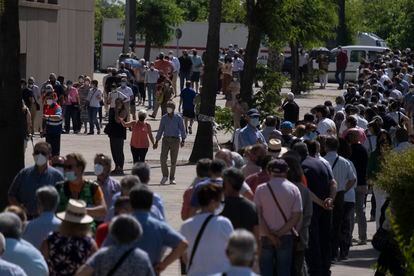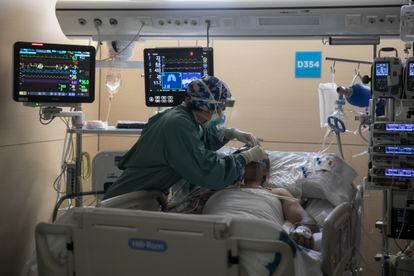May ends with the lowest monthly number of coronavirus deaths in Spain since August
The director of the Health Ministry’s Coordination Center for Health Alerts says that the “progress of transmission is stable,” and will likely “hold steady in the coming weeks”
/cloudfront-eu-central-1.images.arcpublishing.com/prisa/TC3UUVHAVTB7ASU5POUGLIJUJE.jpg)

Spain ended the month of May with the lowest number of Covid-19 deaths since last summer, while a downward trend that health experts consider to be unstoppable was consolidated in the data. The progress in overcoming the pandemic is largely down to the speed of the vaccination campaign, with 2.3 million people having received a shot in the last week, taking the total number of citizens who have been given at least one dose of a Covid-19 vaccine to 18 million – 38% of the total population.
The number of Covid deaths over the last 31 days, which came in at 1,731 victims, gives an idea of the magnitude of the impact the pandemic has had in Spain, even as the vaccination campaign takes effect. According to official figures from the Health Ministry, there have been 80,000 victims in total, although the real number is likely much higher given the lack of testing available at the outset of the crisis.
The ministry reported 48 Covid deaths on Monday, compared to figures between 91 and 103 on the previous three Mondays
While the number of deaths in May remains high, the total is nearly 40% down on the total for April (2,757), and nearly a quarter of the figure for March (6,317). The curve continues to fall, with the ministry reporting 48 Covid deaths on Monday, compared to totals of between 91 and 103 on the previous three Mondays.
Not since August 2020, when 649 Covid deaths were recorded, has the data been so positive. All of the cited data has been reported by the Health Ministry, and has yet to be consolidated by the Carlos III Health Institute in Madrid.
The new cases reported by the ministry on Monday came in at 9,732, in line with the now gentle fall in that figure. In some regions, with Andalusia at the forefront, infection figures are starting to rise slightly. Speaking last night at a press conference to present the latest data, Fernando Simón, the director of the Health Ministry’s Coordination Center for Health Alerts (CCAES), said that the “progress of transmission is stable and it is very likely that it will hold steady in the coming weeks.”
Health experts agree that the end of the pandemic is getting nearer, but that there is a long way to go before normality returns. After weeks of falls in the incidence of the virus, the figures are now starting to plateau. Quique Bassat, an epidemiologist and researcher at the ISGlobal institute in Barcelona, explained that this “was an expected change after the relaxation of measures brought by the end of the state of alarm.” He was referring to the recent expiration of the emergency situation that had been place in six months, and that gave the country’s regions the power to impose nighttime curfews and perimetral lockdowns of their territories, thus limiting travel across the country.
The immense majority of Spain’s risk population, whether due to age or pre-existing conditions, is now vaccinated in Spain
“Some of us even expected a marked increase in diagnoses,” Bassat continued. “But the clinical repercussion that it would have had would have been scant, given that the rise in cases would have been among the younger population. [This group] engages in more risky behavior, but also ends up with less serious symptoms [from the coronavirus],” he concluded.
The immense majority of Spain’s risk population, whether due to age or pre-existing conditions, is now vaccinated in Spain, the experts are relieved to report. “New [hospital] admissions are among younger people who show better clinical progress,” explained José Miguel Cisneros, the chief of service for infectious diseases at the Virgen del Rocío Hospital in Seville. “But we still cannot relax as a society. First, because while hospital occupation is falling, it is going slowly. And second, because there are still some vulnerable profiles being affected by the virus.”

One of these groups is people with weakened immune systems, among whom the vaccines are less effective and as a result are registering high rates of hospitalization. “The others are those who have been recently vaccinated, who relax their protection measures too quickly and end up getting infected when their immune systems are yet to have developed sufficient defenses,” Cisneros explained.
The curves on the graphs detailing the number of deaths during the pandemic paint a picture of a sharp fall in victims in all of the regions and in Spain as a whole. They still remain high, however, with more than 50 Covid-19 deaths a day in the last month. But it is expected that in the coming weeks the data will follow the trend that has been seen in the United Kingdom, a country where the vaccination campaign has moved quicker than it has in Spain and that has enjoyed several weeks now with a single-digit average of daily deaths.
According to the latest ministry data, there are 4,858 Covid-19 patients in Spanish hospitals, of whom 1,347 are in intensive care units
The experts explained that very few deaths are being seen among new infections, given that there are very few hospitalizations among higher-risk groups who have already been immunized. “The majority of deaths now are among patients who have been in hospital for many weeks,” Cisneros explained. “In many cases, they were somewhat younger people, who were able to ride out these long admissions, but that unfortunately, in the end, were not able to overcome the infection.”
According to the latest ministry data, there are 4,858 Covid-19 patients in Spanish hospitals, of whom 1,347 are in intensive care units (ICUs). The figures are down 756 and 280, respectively, on the previous week. These falls are likely to continue in the coming weeks and will likely have a greater effect on the number of deaths than the number of new cases.
The experts are forecasting that infection rates are likely to oscillate in the coming weeks. “The rise in mobility and social interactions will pull the incidence up,” Bassat explained. “But we have a cushion, the vaccines, which are now notable not just on an individual level, but also on a community level.”

The reproduction rate, the so-called R number – i.e. how many other people an infected person passes the virus on to – has fallen below 1 in recent days. “We have nearly 20% of the population fully vaccinated and this has reduced the R rate by approximately 20%,” he added.
“In my opinion, the incidence will oscillate between 50 and 150 cases per 100,000 inhabitants over 14 days,” Basset argued. “We were starting from very high levels and it seems early to me to consider relaxing measures such as mask-wearing already. For that to happen, it would be desirable to fall to an incidence as low as 10 to 25 cases.”
Mask measures
The Castilla-La Mancha region announced on Monday its intention to remove the obligation to wear a face mask while outside during June, something that Madrid is also considering. Speaking on Monday, Fernando Simón stated that “if the progress continues as it is, [...] masks in open spaces may not be necessary by mid- or late-June and almost definitely by the end of July.” He also added that “indoors, in some very specific collectives where vaccination rates are very high,” it is possible that this measure could also be dropped.
The rise in the incidence being registered in some regions is more notable when the seven-day figure is examined – a data point that is more sensitive than the 14-day figure. In recent weeks, Andalusia has gone from 74 to 83 cases per 100,000 inhabitants in a week; Valencia has moved from 14 to 18; and Castilla-La Mancha from 40 to 50.
This uptick, however, is oscillating. Catalonia, for example, which saw a rise in incidence late last week, saw a new fall on Monday to 40 cases in a seven-day period. For Spain as a whole, the 14-day incidence fell slightly according to Monday’s report, from 124 cases to 122.
English version by Simon Hunter.
/cloudfront-eu-central-1.images.arcpublishing.com/prisa/SL6YJIEWUVCY5KQCQWVGA2ETP4.jpg)
/cloudfront-eu-central-1.images.arcpublishing.com/prisa/DUTSXSDIQVZOQJBVVO67JMPFTA.jpg)










































